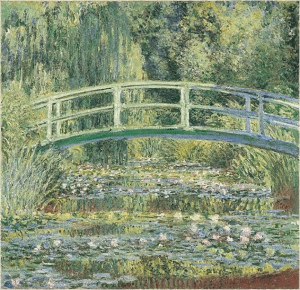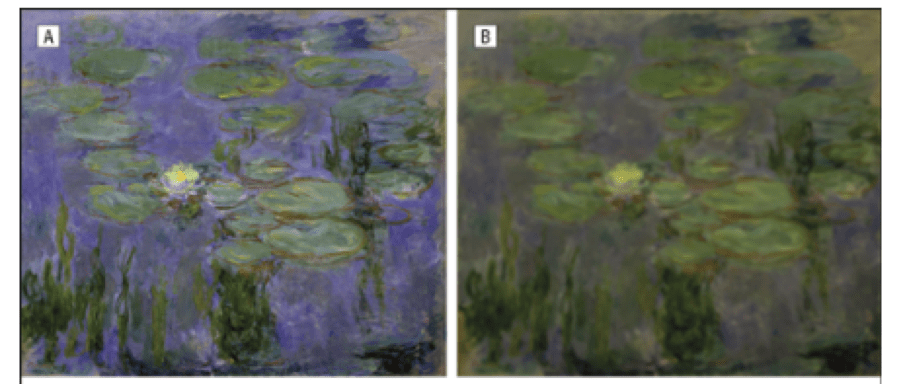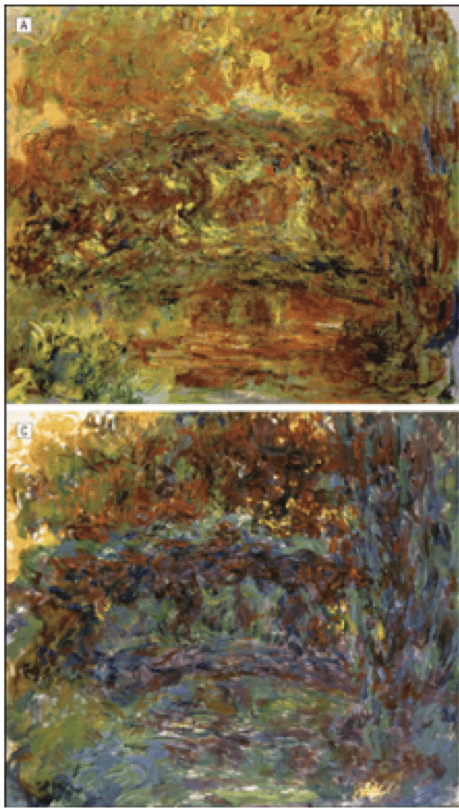 Claude Monet and Water Lilies are almost synonymous. The acclaimed artist who was a founder of French Impressionist painting had a beautiful way of expressing one’s perceptions before nature. His personal ambition to artistically document the French countryside led him to paint these scenes many times over to illustrate different conditions of lighting and the changing of seasons. Interestingly enough, one of his most famous scenes primarily focuses on a lily pond and the Japanese bridge at Giverny, France. This scene, in retrospect, has provided a journey through the aging eye of Monet. Through many historical contexts and records, it is well known that Monet suffered from an age-related Cataract. Let’s take a peek at how those paintings evolve as his eyes aged.
Claude Monet and Water Lilies are almost synonymous. The acclaimed artist who was a founder of French Impressionist painting had a beautiful way of expressing one’s perceptions before nature. His personal ambition to artistically document the French countryside led him to paint these scenes many times over to illustrate different conditions of lighting and the changing of seasons. Interestingly enough, one of his most famous scenes primarily focuses on a lily pond and the Japanese bridge at Giverny, France. This scene, in retrospect, has provided a journey through the aging eye of Monet. Through many historical contexts and records, it is well known that Monet suffered from an age-related Cataract. Let’s take a peek at how those paintings evolve as his eyes aged.
The painting above is a classic work created by Monet in 1899 prior to having any visual problems. At the age of 59, when he painted this piece, one can view the “true” colors perceived by Monet, the detail of each water lily, and the natural resplendence of this scene.
Monet’s cataracts steadily worsened over time, especially from 1912 to 1922. Monet, aware of his failing sight, consulted several Ophthalmologists who recommended cataract surgery. At that time, cataract surgery was relatively safe and did not include implantation of a lens, but still, Monet was reluctant to proceed as he was worried about color perception. In 1915, he stated, “colors no longer had the same intensity for me . . . reds had begun to look muddy . . . my painting was getting more and more darkened.”

The paintings above portray Monet’s representation of a water lily when he presumably had a moderate cataract. When you examine the piece, notice the tinge of yellow that progresses from A to B, along with the loss of detail.
 During his most severe visual disability, these paintings above depict a stark contrast from those created earlier in his life. These late paintings are almost abstract and show a predominant red-orange or green-blue tone that is quite different from the earlier techniques of subtle color shading.
During his most severe visual disability, these paintings above depict a stark contrast from those created earlier in his life. These late paintings are almost abstract and show a predominant red-orange or green-blue tone that is quite different from the earlier techniques of subtle color shading.
In 1923, Monet finally agreed to have his cataracts removed. Monet did very well after surgery and regained acceptable reading vision. After treatment, he was disgusted by some of the works he created late in life and destroyed many of them. Some pieces were, however, salvaged by his family and friends. He struggled with his “new view” of the world that had become so “yellow”. He regained confidence and decided to repaint the water lily. Below you will see the amazing difference with improved detail and replacement of yellow-dominant colors with those more natural tones.
 The works of Monet throughout his life provide a beautiful representation of the aging eye, in particular, the maturation of a cataract. In regards to cataract formation, our world around us changes so slowly that we continually adapt to details and colors around us until it is vastly different than what we know. It is at that time that a patient will notice his or her visual disability. I hope this has been an interesting art history lesson and perhaps it will make all of us more aware of our surroundings and the changes we perceive.
The works of Monet throughout his life provide a beautiful representation of the aging eye, in particular, the maturation of a cataract. In regards to cataract formation, our world around us changes so slowly that we continually adapt to details and colors around us until it is vastly different than what we know. It is at that time that a patient will notice his or her visual disability. I hope this has been an interesting art history lesson and perhaps it will make all of us more aware of our surroundings and the changes we perceive.
If you would like to read a more detailed discussion, please see the citation below from the Archives of Ophthalmology:
Marmor MF. Ophthalmology and Art: Simulation of Monet’s Cataracts and Degas’ Retinal Disease. Arch Ophthalmol. 2006;124(12):1764-1769. doi:10.1001/archopht.124.12.1764
Article by Chirag J. Patel, M.D.


